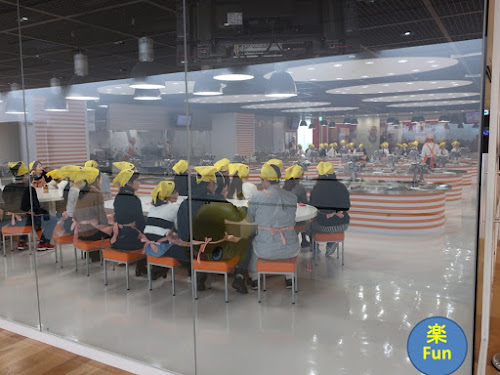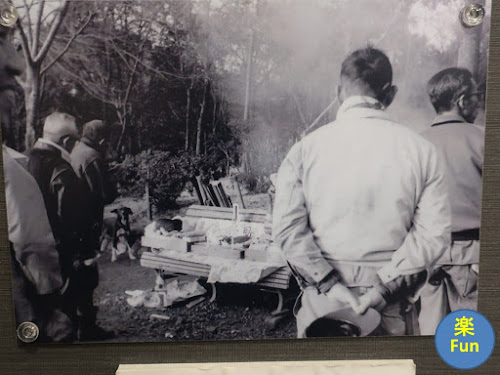Ikeda is the northern end of Osaka Plain, and its northern part is a mountainous area. Therefore, they can use various kinds of material from various places and they can also make various specialties such as fabrics, inkstick (sumi) and sake (alcohol). The city museum introduces its history and folklore of course, and many children and Asian visitors enjoy Cupnoodles Museum because Ikeda is the birthplace of instant noodle. There are Rakugo (comic story telling) Museum, an art museum and so on. It’s a good city.
 |
Information center in front of Ikeda
station
駅前案内所兼アンテナショップ
|
池田は大阪平野の北端、池田より北は山間地となる。色々な材料が手に入るためか、織物、墨、酒など名産品が多い。市立資料館では、歴史や民俗が紹介されているが、最近は、インスタントラーメンの発明の地として、カップヌードル・ミュージアムが大人気だ。子供もアジアからの旅行客も生き生きと楽しんでいた。落語ミュージアムもあり、イベントを選んで来れば、存分に楽しめる。今回紹介はしていないが、阪急の創業者・小林一三の収集品の美術館等もある。
Ikeda History and Folklore Museum、池田市立歴史民俗資料館
The main exhibition room is as large as two class rooms. The permanent exhibition is called “Visualized history of Ikeda” which introduces the history from ancient to modern era.
主展示室(教室二つぐらい)。目で見る池田の歴史という常設展が開かれている。古代から昭和まで展示されている。
 |
View of Ikeda from Somedono-i(well) where legendary princesses dyed threads,
it was a big town. (Settsu Meisho-zue /guide book in 1798)
伝説の織姫クレハトリとアヤハトリが糸を染めたという、染殿井(右下)から望む池田。大きな町場だ。(摂津名所図会、1798年)
|
 |
| Special exhibition of two legendary princesses、特別展パンフレット |
 |
Soldier’s hat which was owned by a powerful village head; he was
allowed to be equipped with samurai outfit. It is made well. 武士の身分を許された大庄屋の陣笠。造りが良い。
|
Ikeda has been a high productive city because it is in the
long-lasting advanced region called “Kinai” (near the capital, Kyoto). It is
also near Osaka which has been a big number of consumers, so they produced lots of crop
such as cotton, vegetables, fruits and supplied them to Osaka. Especially, cotton,
charcoal and orange got high reputation. The photo below shows that a cart drawn by cow carried charcoal in 1917. There is an electricity pylon, but animal power
is still major.
池田は、古くから畿内の村として高い生産力を備えていただけでなく、大阪という大消費地が近かったこともあり、木綿、野菜、果物などの商品作物の生産が盛んであった。木綿や木炭、みかんは高い評価を受けていた。上の写真は、木炭とそれを牛車で運ぶ様子。電塔はあるが、まだ、人力、動物力の世界だ。
 |
Sake brewing in Ikeda and Itami by manpower on Settsu Meisho-zue;
too many people are working. 摂津名所図会に載っている酒造り。ビックリするほど人がいる。人力だ。
|
 |
| Sake brewing equipment、酒造道具 |
Ikeda in the Showa period (1926-1989) 昭和時代の池田
 |
| Yakushi street in 1927、昭和2年の薬師通 |
 |
Honmachi street in 1935: it was a government district, it was also the
time when my mother was born. 昭和10年の本町通り。官庁街だったという。母が生まれたころだ。
|
 |
Festival “Gangara-bi(fire)” which is held in the end of August has
continued since the Edo period. It is the major festival of Ikeda.
8月末に行われる「がんがら火」。江戸初期から続く池田を代表する祭だそうだ。
|
Temporary exhibition: Old utensils、昔の道具の企画展
 |
Old utensils (1910-1960) were shown. Exhibits were sorted by the
purpose such as sawing.
企画展の大正から昭和中期(1910年頃から1960年頃)に使われていた道具の展示。炊飯器なら炊飯器で異なる時代の物を並べているのが面白い。
|
 |
Japanese sewing box; it has a part called “Kuke-dai” which hangs
fabric while working. お針箱。服地を止めておく絎(くけ)台として使える。美しい箱だ。
|
Official website:
http://www.city.ikeda.osaka.jp/kanko/rekishi/rekishiminzokukan/1497685119858.html (Japanese) , accessed in February, 2020
Rakugo (comic story telling) Museum 落語ミュージアム
There are Ikeda themed stories such as “Buying a boar” and “Give praise to the cow”.山間部近くの池田には、猪買いや牛褒めという有名な落語がある。
 |
There is a stage for Rakugo “Kou(high)-za(seat)”
inside. The left side is a tiny exhibition area. 落語ができるステージがあり、右が小さな展示コーナー
|
 |
Photos are exhibited. They hunted a boar. Their dogs
also looked proud.
展示コーナーの写真。猪を射止めた人も犬も誇らしそうだ |
Official website:
https://www.ikedashi-kanko.jp/recommend-spot04.html (in Japanese)
accessed in February, 2020
Shops in the shopping street to the next museum 池田の商店街
 |
There are old school shops in Sakae-machi
shopping street. I saw a seed shop for farmers first time. 池田駅までの商店街にはサカエマチ商店街にはレトロなお店。農家向けの種屋さんは初めて見た。
|
 |
Cleaning and repairing shop for kimono
clothes
和服のクリーニング店。レトロだ。
|
Cupnoodles Museum カップヌードル・ミュージアム
 |
It was a cold winter day, but there were
lots of smiles in this building.
寒い冬の日でしたが、館内は笑顔で溢れていました。
|
 |
Photography area at the entrance. Mr. Ando lived in Ikeda and
started to develop the instant noodle.
池田の自宅でインスタントラーメンを発明した安藤百福。エントランスに撮影コーナーがある。
|
 |
The small house, where he invented the noodle in 1958, is rebuilt.
School tours were held inside; everyone looked happy.
1958年、安藤が一人でインスタントラーメンを試作し、発明した小屋の再現。小学生達が楽しそうに見学していました。
|
 |
The history of the instant noodle business is shown. After opening doors, you can get more
information.
インスタントラーメン事業化の歴史の展示。扉を開けると色々と分かるようになっている。
|
 |
The history of the products which brings back memories.
インスタントラーメン製品の歴史。懐かしい品々が。
|
 |
The big model of the cupnoodle is a good photo spot. Many foreigners
enjoy it.
カップヌードルのカットモデルも撮影スポット。海外の方が楽しんでいました。世界に浸透しています。 |
 |
My cupnoodle factory; you can design and make your cupnoodle for ¥300 (about $3). It was a weekday but people accumulated a queue.
マイ・カップヌードル・ファクトリー。300¥でオリジナルのカップヌードルを作る。平日なのにこの人気です。
|
 |
Chicken Ramen factory; you make it from flour. It is a fully booked
event. Children joined and enjoyed with their parents.
予約制のチキンラーメン・ファクトリー。小麦粉から作る。大人気だ。
|
 |
Mr. Ando’s motto; making food to contribute the society
安藤百福の理念
|
 |
Museum shop is filled with yellow, which is the color of the Chicken Ramen.
ミュジーアムショップは黄色だ。 |
Official website:
https://www.cupnoodles-museum.jp/en/osaka_ikeda/ , accessed in August, 2020
Cupnoodles museum in Yokohama(横浜・みなとみらいにもあります)
https://www.cupnoodles-museum.jp/en/yokohama/
6 funs(楽fun)were found. Visited in February, 2019
Previous post (Museum in the post town near Ikeda):
Kohama juku museum 宝塚市立小浜宿資料館
Next post (Museum in the neighboring city):
Minoh museum 箕面市立郷土資料館










Comments
Post a Comment